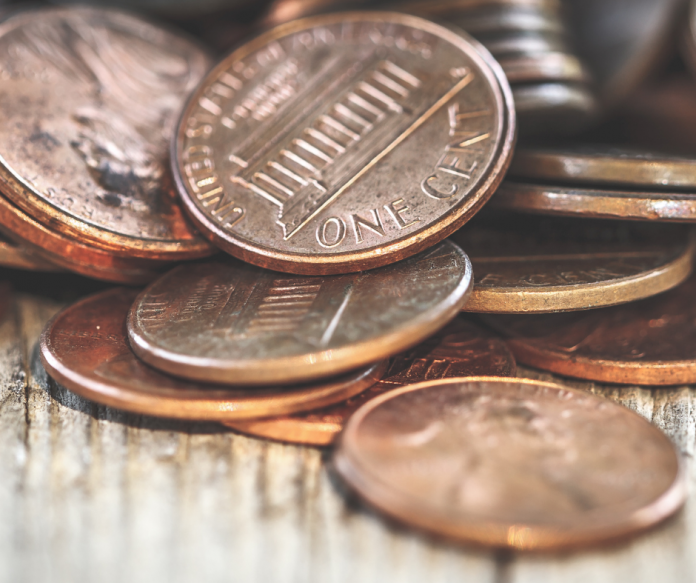
There’s no more familiar fixture in American numismatics than the Lincoln cent. The coin debuted in 1909 and has seen the United States through 20 presidents, two world wars, and the Great Depression.
The tenacious Lincoln cent came along before television, electronic computers, jet planes, space rockets, robots, refrigerators, and even sliced bread.
It has also survived a barrage of attempts to banish it from circulation on the grounds of increasing production costs and economic obsolescence. For years, it has cost well more than one cent to produce the coin. The Lincoln cent has been an endangered species since at least the 1970s when rising copper prices and staggering inflation threatened to snuff the penny out of existence. Today it costs around 1.76 cents to produce one Lincoln cent.
Few people carry pennies around these days, let alone spend them. What’s the point of making a coin whose independent buying power is essentially nil and has little purpose beyond making change?
Who knows how many pennies sit in glass jars, sock drawers and piggy banks today? Some estimates broadly peg the number well into the tens of billions. But the real value of the Lincoln cent today may not rest in its meager spending power but rather its vast potential to lure people into numismatics.
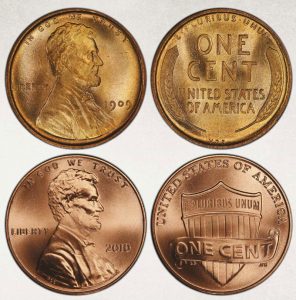
COURTESY OF PROFESSIONAL COIN GRADING SERVICE TRUEVIEW; GETTY IMAGES / OANA GHERGHE / 500PX
Understanding the Love for Lincoln
When the Lincoln cent was released on August 2, 1909, people lined up for hours at the New York City subtreasury building and other locations around the U.S. just to get their hands on the new coin. Designed by Lithuanian American sculptor Victor David Brenner, the Lincoln cent was an instant hit with the young and old.
The lore of the Lincoln cent took on a life of its own right out of the gate, with Secretary of the Treasury Franklin MacVeagh reportedly
surprised about the appearance of Brenner’s “VDB” initials on the reverse of the new coin. He ordered the U.S. Mint to stop minting the Lincoln cent right away to remove the prominent initials, much to the dismay of Brenner. “I am delighted that so much attention has been directed to the new cents,” the artist said. “That pleases me, but the taking of my initials off takes half the satisfaction away.”
The thrill wasn’t gone with collectors, who learned the 1909 Lincoln cents from the Philadelphia and San Francisco Mints that struck the new pennies with “VDB” would soon become collectibles. Within days, the discontinued 1909 VDB Lincoln cent, with a mintage of 27,995,000, was selling three for five cents.
Meanwhile, the much-scarcer 1909-S VDB Lincoln cents, with a mintage of only 484,000, garnered as much as 25 to 50 cents apiece.
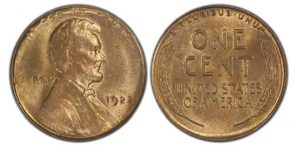
COURTESY OF PROFESSIONAL COIN GRADING SERVICE TRUEVIEW
Diminishing Returns?
Even as early as the 1920s, the cent was a coin with little buying power.
The August 1922 issue of The Numismatist featured an article called “Coin Crop for 1922 a Failure” in which
Mint Director Frank Edgar Scobey is quoted as saying, “As for cents, only $70,000 have been coined at the Denver Mint, as against $492,000 the preceding year… So, what’s the use of making more, when about the only things you can still buy with a penny nowadays are lollypops?”
However, Americans were still in love with the coin a decade later in the 1930s when the first “penny boards” were sold to the public. Soon, millions were actively searching pocket change, purses and coin jars for Lincoln cents of every date and mintmark. Some issues were proving harder to find than others – the 1914-D, just about every San Francisco date before 1918, the 1922 no D, the 1926-S and the 1931-S.
Fueling a Revolution
In 1943, with World War II rations fully underway, the U.S. Mint switched to a zinc-coated steel planchet to conserve copper for the war effort. But when a few bronze planchets ended up getting stuck with the 1943 dies, the search was on for the valuable transitional error.
When numismatics took off during the 1950s, millions were paying close attention to their change looking for scarce dates and key dates. But when 1955 doubled die Lincoln cent emerged, it caused widespread hysteria and quickly became the most popular die variety – arguably a claim it still holds today.
Lincoln cent enthusiast Stewart Blay fondly recalls the mid-century golden era of collecting coins. “The Lincoln Cent was the first coin I collected,” says the collector whose Lincoln cent set ranks atop the Professional Coin Grading Service’s competitive registry. “In my opinion, there are more famous Lincoln cents that can be found in circulation than any other coin denomination, such as the 1909-S VDB, 1914-D, 1922 no D, 1943 copper cent, 1955 doubled die, 1969-S doubled die, and others.”
He says some of the unique challenges in collecting a complete Lincoln cent set are the many doubled dies, the early matte proofs, overdates, and the mega-rarities like the 1943 bronze and 1944 steel cent transitional errors.
“Some of my favorite coins are my 1909 VDB matte proof, 1909-S VDB graded MS-67, 1919 MS-69 Red, 1922 no D MS-64 Red, and my 1958 doubled die and 1969 doubled die obverse specimens.” What’s the draw to pennies like these? “The allure of the 1909-S VDB, 1914-D, 1922 no D, and 1955 doubled die is the word valuable.”
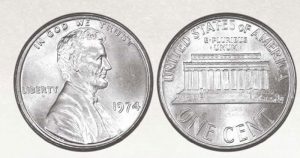
COURTESY OF PROFESSIONAL COIN GRADING SERVICE TRUEVIEW
Metal Prices Test the Penny
In the mid-1970s, the copper metal value of the penny doubled, then tripled. Calls to eliminate the penny or change its composition to a cheaper metal resulted in a 1974 aluminum prototype that was struck to the tune of more than 1.5 million pieces.
All were recalled when copper prices settled back and the mint discontinued its aluminum penny experiment. Yet, a compositional change was again front and center when copper prices soared in the late 1970s and early ‘80s, ushering in the copper-coated zinc Lincoln cents first issued in 1982.
Calls to eliminate the Lincoln cent became more vocal throughout the 1980s and ‘90s, with then-Delaware Republican Representative Mike Castle spearheading a campaign in 1996 to explore the potential of nixing the cent. “I’ve looked at the polls, which show less and less acceptance of the penny,” he said to reporters at The Baltimore Sun for a September 1996 article. “I’ve personally observed the disregard for it in a variety of stores, which wave it off.”
Not Uncharted Territory
The Lincoln cent is a part of the lexicon, with common sayings like “a penny saved is a penny earned” and “find a penny pick it up, all day long you’ll have good luck.” How many people have tossed pennies into water fountains to make a wish? And how many folks carry the name “Penny?”
A 2015 Harris poll found that 51% of Americans opposed abolishing the one-cent coin, and a more recent 2019 survey by Americans for Common Cents found 68% of respondents voting to keep the penny – even as more and more people use plastic to buy goods and services.
In the United States, the half cent was kicked off production in 1857 because of rising copper prices and the coin’s evaporating value then. Yet, the equivalent value of the half cent in 1857 would equal more than a dime in today’s world. So, why keep around a coin whose value is so little?
“Going by Canada’s experience with this matter back in 2012 and 2013, the public accepted the discontinuance of their one-cent coins with hardly any hitches,” said coin expert Maurice Rosen. “The sky didn’t fall.”
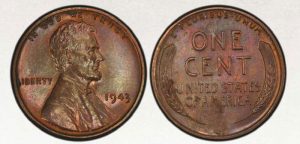
COURTESY OF PROFESSIONAL COIN GRADING SERVICE TRUEVIEW
A Penny Saved is a Penny Learned
“If Washington lobbyists for the base metals industry are unable to reverse legislation to pull the plug on the one-cent coin in the U.S. the general public likely won’t give it more than a passing thought,” Rosen says. “Though some coin collectors might be upset.”
And there’s the rub. The Lincoln cent is an important coin – to Americans in general, and especially to numismatists. Longtime dealer Charmy Harker, widely known as “The Penny Lady,” refers to the Lincoln cent as a “gateway” coin that brings many people into the hobby.
Originally drawn to Indian cents in her youth, Harker feels the Lincoln cent holds an especially integral place with today’s collectors. “Lincoln cents are probably more prevalent with today’s younger collectors because they are easier to find and search through wheat cents that are still available in rolls from banks, bags from coin shops, and/or jars and cans filled with pennies that were stowed away in pantries.”
Lincoln Cent’s Legacy Will Carry On
Lincoln cent expert Charles Daughtrey is confident that American numismatics will carry on whether or not the Lincoln cent hits the chopping block. “I highly doubt cutting cents from commerce would kill collecting coins,” he says.
“I do believe, however, that there are enough existing coins out there to spread among collectors that a sudden withdrawal of the coin from commerce would probably have a more positive impact on collectors.”
Daughtrey believes the size of the newcomer collector base for Lincoln cents is proportionately larger than it is for other coins. “They are easy to acquire, are rather inexpensive, and in all collector levels they are one of the largest and most challenging series to collect,” he says.
This article about lincoln pennies previously appeared in COINage magazine. To subscribe click here. Article by Joshua McMorrow-Hernandez.












